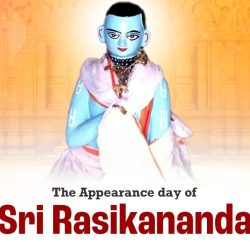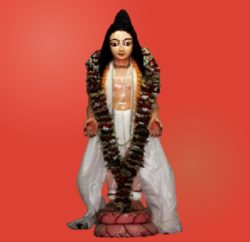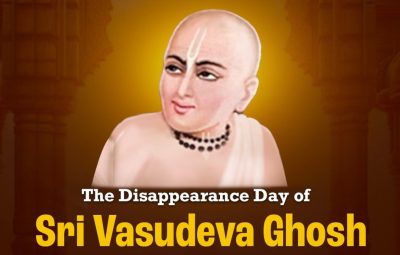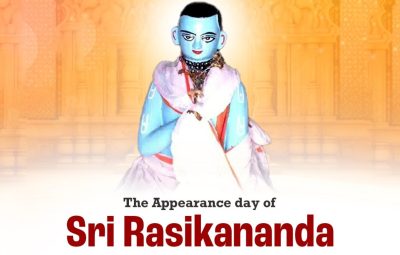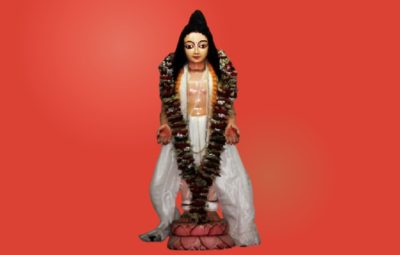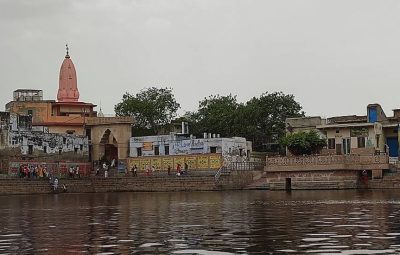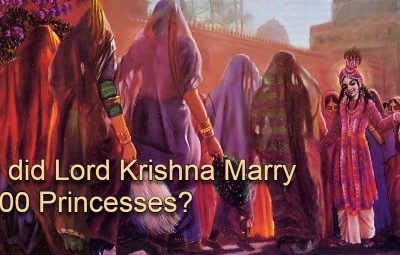Krishna dasa Kaviraja Goswami writes (Caitanya-caritamrita, Adi-lila 10.115): “The three brothers, Govinda, Madhava, and Vasudeva were the eighty-second, eighty-third, and eighty-fourth branches of the Sri Chaitanya tree. He lived along with his two brothers in a village named ‘Kulai’ which lies on the bank of Ajay river, 20KM west to Katwa. His Divine Grace Vishwa Guru Abhaya Charanarvrinda Bhaktivedanta Swami Srila Prabhupada writes in Sri Chaitanya Charitamrita that Sri Vasudeva Ghosh and his brothers belonged to the kayastha family.
Sri Govinda Ghosh along with his brothers, was present in the kirtans at Srivas Angan, in the kirtan party which went to the Kazi’s house, in the kirtan’s at Raghav Pandit’s house and were among one of the seven parties that performed kirtana at the Ratha-yatra festival at Jagannatha Puri. Vakreśvara Paṇḍita was the chief dancer in their party. It is said that when the three brothers performed sankirtana, immediately Lord Chaitanya and Nityananda would dance in ecstasy. They had very sweet voices.
According to Srila Bhaktisiddhanta Saraswati Prabhupada these three are situated in the madhurya-rasa and are in the section of those who have accepted Sri Radhika as their ultimate ashraya-vigraha [object of worship].
Lord Caitanya instructed several devotees, including Lord Nityananda, to leave Puri and return to Bengal to spread His teachings. Among those sent back were Srila Vasudeva Ghosh and his brother Madhava Ghosh. Upon their return, Sri Madhava Ghosh set up his place of worship at Dainhat (close to Katwa), while Srila Vasudeva Ghosh made Tamluk his base. Their third brother, Sri Govinda Ghosh, later founded his devotional residence at Agradwip.
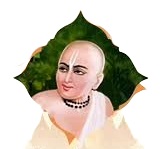
Sri Vasudeva Ghosh chose to establish his devotional cottage at the precise location where Lord Caitanya had once stopped during His journey to Puri through Tamluk. Today, the ‘Sri Mahaprabhu Mandira’ stands at this sacred spot and is recognized as the Sripat of Sri Vasudeva Ghosh. From this place, he actively propagated the teachings of devotional yoga. Sri Vasu Ghosh blessed the world with countless soul-stirring devotional songs that celebrate Lord Caitanya and His boundless merciful activities. Due to this extraordinary contribution, Sri Vasu Ghosh is sometimes honored as the foremost poet among Gaudiya Vaishnavas. It is believed that the profound devotional emotions expressed in his songs possessed such power that they could melt even wood and stone. He composed many bhajans glorifying Lord Gauranga.
Sri Govind Ghosh was among the devotees who traveled with Mahaprabhu on His pilgrimage to Vrindavan. During one occasion on this journey, Mahaprabhu requested Haritaki, a mouth freshener, following His meal. Govinda promptly offered one to Him. However, Mahaprabhu was aware that Govinda had a habit of storing some Haritaki for future use. Displeased by this, the Lord instructed him to stay at that location, install a deity, and dedicate himself to worship. Through this incident, the Lord taught spiritual practitioners an important lesson: one should not accumulate or save things out of anxiety, but instead trust that Krishna will fulfill all genuine needs. Though deeply saddened, Govinda obeyed Mahaprabhu’s command and remained at Agradwip. Following the Lord’s guidance, he installed the deity of Gopinath there. He later married and was blessed with a son, and together with his family, he lovingly served Gopinath with devotion.
However, by the Lord’s will his wife and son soon departed from this world, plunging him into profound sorrow. Overwhelmed by grief, Govinda found himself unable to worship Gopinath for several days. One day, the deity Gopinath spoke to him, pointing out the injustice of neglecting one son (Gopinath himself) due to mourning another. In response, Govinda expressed his concern about who would perform the final funeral ceremonies for him when his time came. Gopinath consoled him with the promise that He would personally conduct those sacred rites. This assurance filled Govinda Ghosh with immense joy, and he immediately resumed serving the Lord with renewed devotion.
In due course of time, when Govinda Ghosh left this world on this auspicious day after instructing the devotees to not burn his body but rather bury his body near Dolaprangan, Gopinath took kusha grass in his fingers and performed the last rites for his dear devotee. This practice continues even today.
In Tamluk, at the Sripat of Vasudeva Ghosa Thakura, is a very beautiful Deity of Mahaprabhu, standing with His hands in an interesting mudra (pose), quite unlike any other Deity of Mahaprabhu anywhere else.
In this connection, there is a story. When Vasudeva Ghosa received the news of Mahaprabhu’s departure from this world, he promptly proceeded to dig his own samadhi, and then sat down inside it, to wait for his final breath. Mahaprabhu then appeared there, and with one hand He offered His benediction, and with the other indicated that Vasudeva should get up out of the hole.
According to the Gaura-gaṇoddeśa-dīpikā (188), the three brothers were formerly Kalāvatī, Rasollāsā and Guṇatuṅgā, who recited the songs composed by Sri Vishakha-gopi.


